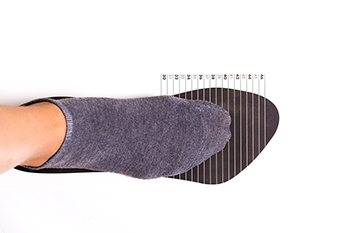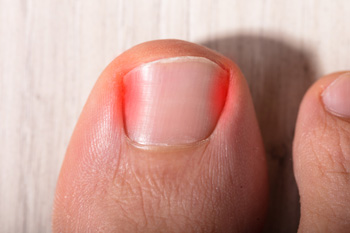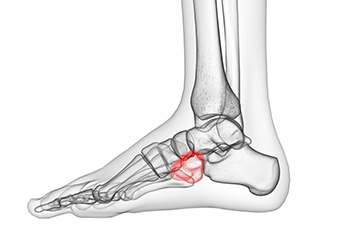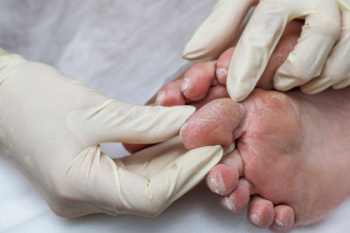Connect With Us
Blog

Wearing the correct shoe size is vital for foot health and overall comfort. Shoes that are too tight or too loose can cause a variety of foot problems. Wearing tight shoes can lead to blisters, calluses, and bunions, while shoes that are too loose can cause instability, leading to sprained ankles or difficulty walking. Inappropriate shoe sizes can also contribute to conditions like hammertoes, corns, or nerve damage. Additionally, wearing ill-fitting shoes can impact posture, leading to back, knee, or hip pain. Children’s feet are especially prone to damage if their shoes do not fit properly as they are still growing. If you have foot pain, possibly from wearing the wrong size shoes, it is suggested that you consult a podiatrist who can treat various foot conditions, and guide you on how to find your right shoe size.
Finding a properly-fitting shoe is important in reducing injuries and preventing foot problems. For more information about treatment, contact Charles Passet, DPM from Forest Hills. Our doctor will treat your foot and ankle needs.
Proper Shoe Fitting
A common concern when it comes to foot health, having properly fitted shoes can help prevent injuries to the foot. Out feet affect our posture and gait, which in turn affects the biomechanics and overall bodily structure. With 33 joints, 26 bones, and over 100 ligaments, the potential for serious injury is much greater than one realizes. Although the feet cease growth in adulthood, they still change shape as they mature. Here are some factors to consider when it comes to investing in proper fitting shoes:
- Be sure the shoes fit correctly right away
- Ensure the ball of your foot fits comfortably in the widest portion of the shoes
- Even though they may look fashionable, improper fitting shoes can either create adverse conditions or exacerbate existing ones you may already have
- Walk along a carpeted surface to ensure the shoes comfortably fit during normal activity
Keeping in mind how shoes fit the biomechanics of your body, properly-fitting shoes are vitally important. Fortunately, it is not difficult to acquire footwear that fits correctly. Be sure to wear shoes that support the overall structure of your body. Do your feet a favor and invest in several pairs of well-fitted shoes today.
If you have any questions please feel free to contact our office located in Forest Hills, NY . We offer the newest diagnostic and treatment technologies for all your foot and ankle needs.

An ingrown toenail may seem like a minor issue at first, but it can quickly lead to significant discomfort and infection. This condition occurs when the edge of a toenail grows into the surrounding skin, often causing redness, swelling, and pain. Wearing tight footwear, improper nail trimming, and even genetics can increase the likelihood of developing an ingrown nail. Left untreated, the area can become infected, making walking difficult and daily activities uncomfortable. While home remedies may offer temporary relief, they often do not address the underlying problem. A podiatrist can provide effective treatment, which may include lifting the nail, removing part of it, or offering guidance on prevention. Early intervention can prevent complications, especially for those with diabetes or circulation issues. If you notice persistent pain, swelling, or signs of infection in your toe, it is suggested that you see a podiatrist for a proper diagnosis and treatment.
Ingrown toenails can become painful if they are not treated properly. For more information about ingrown toenails, contact Charles Passet, DPM of Forest Hills. Our doctor can provide the care you need to keep you pain-free and on your feet.
Ingrown Toenails
Ingrown toenails occur when a toenail grows sideways into the bed of the nail, causing pain, swelling, and possibly infection.
Causes
- Bacterial infections
- Improper nail cutting such as cutting it too short or not straight across
- Trauma to the toe, such as stubbing, which causes the nail to grow back irregularly
- Ill-fitting shoes that bunch the toes too close together
- Genetic predisposition
Prevention
Because ingrown toenails are not something found outside of shoe-wearing cultures, going barefoot as often as possible will decrease the likeliness of developing ingrown toenails. Wearing proper fitting shoes and using proper cutting techniques will also help decrease your risk of developing ingrown toenails.
Treatment
Ingrown toenails are a very treatable foot condition. In minor cases, soaking the affected area in salt or antibacterial soaps will not only help with the ingrown nail itself, but also help prevent any infections from occurring. In more severe cases, surgery is an option. In either case, speaking to your podiatrist about this condition will help you get a better understanding of specific treatment options that are right for you.
If you have any questions please feel free to contact our office located in Forest Hills, NY . We offer the newest diagnostic and treatment technologies for all your foot and ankle needs.

Cuboid syndrome occurs when the cuboid bone in the foot becomes misaligned, leading to pain and difficulty with movement. This often results from excessive stress on the foot, such as repetitive motion or an improper landing after a jump. Symptoms include sharp pain along the outer side of the foot, swelling, and difficulty bearing weight. Some individuals may notice a feeling of instability or weakness while walking or running. Risk factors include participation in high-impact sports, footwear with inadequate support, and a having pre-existing foot condition, such as flat feet. Those who suddenly increase their activity levels without proper conditioning may also be more susceptible. If you have pain in this part of your foot, it is suggested that you consult a podiatrist who can accurately diagnose cuboid syndrome, and offer appropriate treatment solutions.
Cuboid syndrome, also known as cuboid subluxation, occurs when the joints and ligaments near the cuboid bone in the foot become torn. If you have cuboid syndrome, consult with Charles Passet, DPM from Forest Hills. Our doctor will assess your condition and provide you with quality foot and ankle treatment.
Cuboid syndrome is a common cause of lateral foot pain, which is pain on the outside of the foot. The condition may happen suddenly due to an ankle sprain, or it may develop slowly overtime from repetitive tension through the bone and surrounding structures.
Causes
The most common causes of cuboid syndrome include:
- Injury – The most common cause of this ailment is an ankle sprain.
- Repetitive Strain – Tension placed through the peroneus longus muscle from repetitive activities such as jumping and running may cause excessive traction on the bone causing it to sublux.
- Altered Foot Biomechanics – Most people suffering from cuboid subluxation have flat feet.
Symptoms
A common symptom of cuboid syndrome is pain along the outside of the foot which can be felt in the ankle and toes. This pain may create walking difficulties and may cause those with the condition to walk with a limp.
Diagnosis
Diagnosis of cuboid syndrome is often difficult, and it is often misdiagnosed. X-rays, MRIs and CT scans often fail to properly show the cuboid subluxation. Although there isn’t a specific test used to diagnose cuboid syndrome, your podiatrist will usually check if pain is felt while pressing firmly on the cuboid bone of your foot.
Treatment
Just as the range of causes varies widely, so do treatments. Some more common treatments are ice therapy, rest, exercise, taping, and orthotics.
If you have any questions, please feel free to contact our office located in Forest Hills, NY . We offer the newest diagnostic and treatment technologies for all your foot care needs.

Diabetes can cause serious problems for your feet if not managed well. High blood sugar levels can damage the nerves in your feet, leading to numbness, tingling, or loss of feeling, which is called diabetic neuropathy. When you cannot feel pain, you might not notice cuts, blisters, or sores. Diabetes can also slow down blood flow, making it harder for wounds to heal and increasing the risk of infection. If infections are not treated quickly, they can lead to serious complications, including loss of limbs. Daily foot care is important for people with diabetes. Check your feet every day for cuts, redness, or swelling, and wear shoes that protect your feet. If you have diabetes, it is suggested that you see a podiatrist regularly for help in addressing problems early and keeping your feet healthy.
Diabetic foot care is important in preventing foot ailments such as ulcers. If you are suffering from diabetes or have any other concerns about your feet, contact Charles Passet, DPM from Forest Hills. Our doctor can provide the care you need to keep you pain-free and on your feet.
Diabetic Foot Care
Diabetes affects millions of people every year. The condition can damage blood vessels in many parts of the body, especially the feet. Because of this, taking care of your feet is essential if you have diabetes, and having a podiatrist help monitor your foot health is highly recommended.
The Importance of Caring for Your Feet
- Routinely inspect your feet for bruises or sores.
- Wear socks that fit your feet comfortably.
- Wear comfortable shoes that provide adequate support.
Patients with diabetes should have their doctor monitor their blood levels, as blood sugar levels play such a huge role in diabetic care. Monitoring these levels on a regular basis is highly advised.
It is always best to inform your healthcare professional of any concerns you may have regarding your feet, especially for diabetic patients. Early treatment and routine foot examinations are keys to maintaining proper health, especially because severe complications can arise if proper treatment is not applied.
If you have any questions please feel free to contact our office located in Forest Hills, NY . We offer the newest diagnostic and treatment technologies for all your foot and ankle needs.

